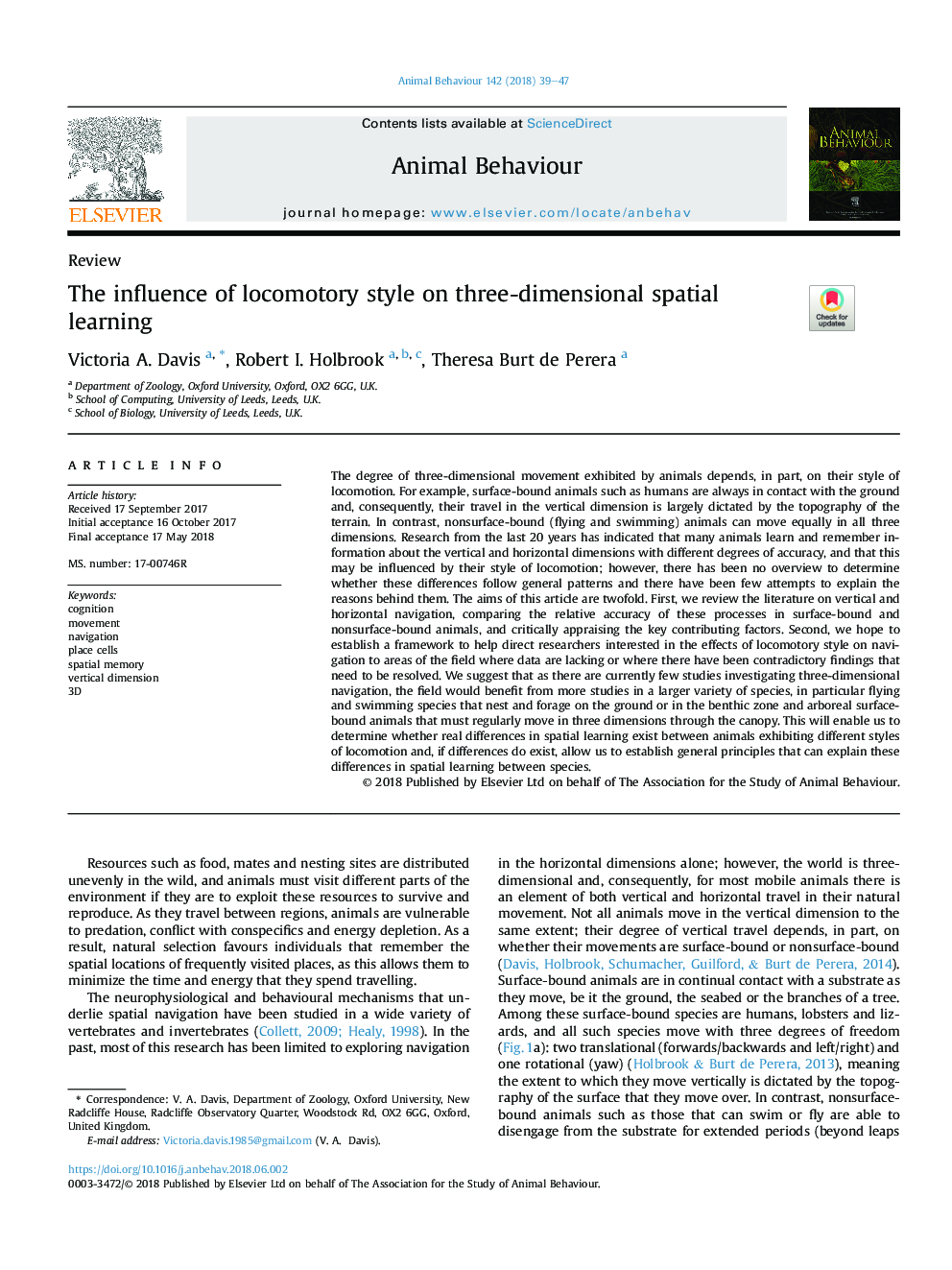| کد مقاله | کد نشریه | سال انتشار | مقاله انگلیسی | نسخه تمام متن |
|---|---|---|---|---|
| 8488403 | 1552186 | 2018 | 9 صفحه PDF | دانلود رایگان |
عنوان انگلیسی مقاله ISI
The influence of locomotory style on three-dimensional spatial learning
ترجمه فارسی عنوان
تأثیر سبک حرکتی در یادگیری فضایی سه بعدی
دانلود مقاله + سفارش ترجمه
دانلود مقاله ISI انگلیسی
رایگان برای ایرانیان
کلمات کلیدی
ترجمه چکیده
درجه جنبش سه بعدی که توسط حیوانات نمایش داده می شود، بخشی از سبک های حرکتی آن است. به عنوان مثال، حیوانات با سطح سطح مانند انسان همیشه در تماس با زمین هستند، و در نتیجه، سفر آنها به ابعاد عمودی به طور عمده توسط توپوگرافی زمین است. در مقابل، حیوانات بدون پرواز (شنا و شنا) می توانند به طور مساوی در تمام سه بعد حرکت کنند. تحقیقات از 20 سال گذشته نشان داده است که بسیاری از حیوانات اطلاعات مربوط به ابعاد عمودی و افقی را با سطوح مختلف دقت یاد می گیرند و به یاد می آورند و این ممکن است تحت تاثیر سبک های حرکت آنها باشد؛ با این حال، هیچ نظری برای تعیین اینکه آیا این تفاوت ها از الگوهای عمومی پیروی می کنند یا نه، وجود دارد و تلاش های کمی برای توضیح دلایل آنها صورت گرفته است. هدف این مقاله دوگانه است. ابتدا ادبیات مربوط به ناوبری عمودی و افقی را بررسی می کنیم و دقت نسبی این فرایندها را در حیوانات سطح محدود و بدون سطوح مقایسه می کنیم و از عوامل کلیدی مهم ارزیابی می کنیم. دوم، ما امیدواریم که یک چارچوبی برای کمک به پژوهشگران متعهد به اثرات سبک حرکتی بر روی ناوبری به حوزه های زمینه ای که داده ها فاقد هستند یا جایی که یافته های متناقضی وجود دارد که باید حل شوند، ایجاد کنیم. ما پیشنهاد می دهیم که در حال حاضر مطالعات کمی در مورد ناوبری سه بعدی وجود دارد، این مزرعه از مطالعات بیشتر در گونه های وسیع تر، به خصوص گونه های شنا و شنا که لانه ها و علوفه در زمین و یا در منطقه بتونی و سطح آبزی حیوانات حیواناتی که باید به طور منظم از طریق طناب به سه بعد حرکت کنند. این امر ما را قادر می سازد تا مشخص کنیم آیا تفاوت های واقعی در یادگیری فضایی بین حیوانات وجود دارد که سبک های مختلف حرکت را دارند و اگر تفاوت ها وجود داشته باشد، ما می توانیم اصول کلی را که می تواند این تفاوت ها را در یادگیری فضایی بین گونه ها توضیح دهیم.
موضوعات مرتبط
علوم زیستی و بیوفناوری
علوم کشاورزی و بیولوژیک
علوم دامی و جانورشناسی
چکیده انگلیسی
The degree of three-dimensional movement exhibited by animals depends, in part, on their style of locomotion. For example, surface-bound animals such as humans are always in contact with the ground and, consequently, their travel in the vertical dimension is largely dictated by the topography of the terrain. In contrast, nonsurface-bound (flying and swimming) animals can move equally in all three dimensions. Research from the last 20 years has indicated that many animals learn and remember information about the vertical and horizontal dimensions with different degrees of accuracy, and that this may be influenced by their style of locomotion; however, there has been no overview to determine whether these differences follow general patterns and there have been few attempts to explain the reasons behind them. The aims of this article are twofold. First, we review the literature on vertical and horizontal navigation, comparing the relative accuracy of these processes in surface-bound and nonsurface-bound animals, and critically appraising the key contributing factors. Second, we hope to establish a framework to help direct researchers interested in the effects of locomotory style on navigation to areas of the field where data are lacking or where there have been contradictory findings that need to be resolved. We suggest that as there are currently few studies investigating three-dimensional navigation, the field would benefit from more studies in a larger variety of species, in particular flying and swimming species that nest and forage on the ground or in the benthic zone and arboreal surface-bound animals that must regularly move in three dimensions through the canopy. This will enable us to determine whether real differences in spatial learning exist between animals exhibiting different styles of locomotion and, if differences do exist, allow us to establish general principles that can explain these differences in spatial learning between species.
ناشر
Database: Elsevier - ScienceDirect (ساینس دایرکت)
Journal: Animal Behaviour - Volume 142, August 2018, Pages 39-47
Journal: Animal Behaviour - Volume 142, August 2018, Pages 39-47
نویسندگان
Victoria A. Davis, Robert I. Holbrook, Theresa Burt de Perera,
